Pay Once and Have Free Attractions Entry for 2, 3, 5 or 7 days
Istanbul is a city that seamlessly blends ancient history with modern convenience, and one of the best ways to explore this vibrant metropolis is by using its efficient public transportation system. The Istanbul Tram T1 is a crucial transport link that connects the city’s most popular attractions, districts, and transit hubs. In this comprehensive guide, we will provide you with all the essential information you need to make the most of your journey on the T1 tram in Istanbul: the fares, the map, the best stations, and the schedule!
Don’t miss our transport guide for tourists in Istanbul!
Why Istanbul’s Tram T1 is the Best Way to Sightsee
The T1 tram line in Istanbul is a modern, efficient, and convenient mode of transportation that connects the city’s most prominent districts and tourist attractions. Running from Bağcılar to Kabataş, the T1 tram line serves as a vital link for locals and visitors alike, providing easy access to some of the city’s most iconic landmarks, including the Grand Bazaar, Blue Mosque, Hagia Sophia, and Topkapi Palace.
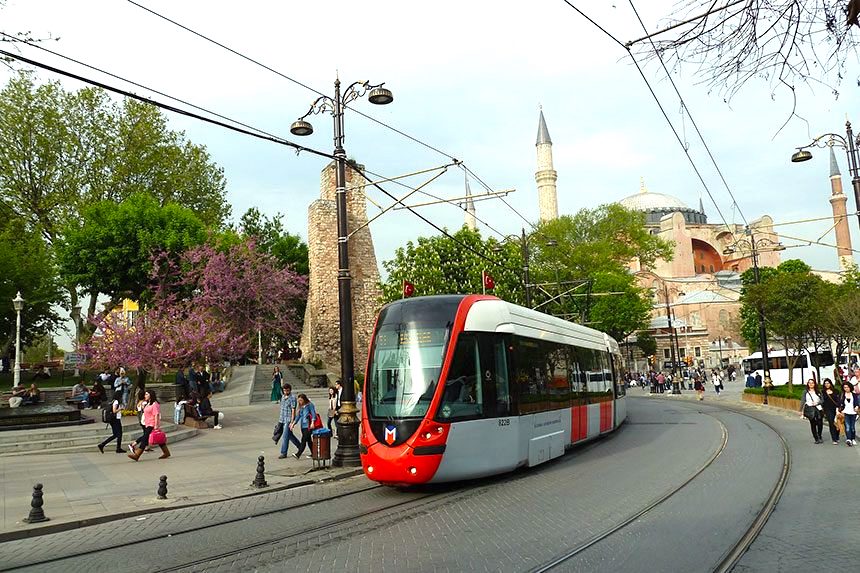
Operational Hours & Fare of the T1 Istanbul Tram
- T1 trams run approximately every 10 to 15 minutes from 06:00 am until 00:00/24:00 (12 midnight) daily.
- The fare for the T1 tram can be paid using the Travel City Card or Istanbulkart, which costs 15 TL and can be purchased at any tram station, or single, two, three, five, and ten pass tickets, which can be purchased at vending machines or kiosks located at tram stations.
- The T1 tram line connects various districts in Istanbul, including Bağcılar, Zeytinburnu, Yusufpaşa/Aksaray, Sultanahmet, Sirkeci, Eminönü, Karaköy, Tophane, and Kabataş.
The Istanbul City Card for T1 Tram in Istanbul
Unlock the wonders of Istanbul with the Istanbul City Card, a passport to unlimited public transportation throughout the city. Effortlessly navigate its vibrant streets, hopping between enchanting attractions and soaking up the rich tapestry of local life.
The Istanbul City Card comes with 1-3-5-7-15 day options for you to choose from, so you can tailor your experience to the length of your stay and explore Istanbul to your heart’s content. Say farewell to ticket queues and embrace the freedom to roam, as this indispensable pass propels you on an unforgettable urban adventure.
Easily purchase it online and have it delivered to your hotel for ultimate convenience. To buy a transport card, click on the link below:
Don’t Miss The Best Tours and Cruises in Istanbul
Exploring Istanbul with the Tram Line T1 Map for 2024
To make your journey on the T1 tram as smooth and enjoyable as possible, it’s essential to familiarize yourself with the Istanbul tram map. The map outlines the various stops on the T1 tram line, helping you plan your trip and ensure you don’t miss any of the city’s must-see attractions.
Discover Istanbul’s Rich History Along the T1 Tram Route
The T1 tram line in Istanbul offers a journey through the city’s rich history, with a route that passes by some of its most iconic landmarks and districts. In this section, we will provide a detailed description of the T1 tram route, highlighting the key attractions and points of interest you can expect to encounter along the way.
From Bağcılar to Zeytinburnu and the Byzantine City Walls of Istanbul with T1 Tram
The T1 tram route begins in the bustling district of Bağcılar, before making its way to Zeytinburnu on the shores of the Sea of Marmara (see the map). Here, passengers can enjoy picturesque views of the sea while traveling along the historic coastline. As the tram moves northeast, it passes through the Byzantine city walls at Topkapı, also known as the Cannon Gate. This landmark should not be confused with the famous Topkapı Palace, which is located further along the route.
Read more about Byzantine History of Istanbul >>
Eastward Through Yusufpaşa/Aksaray and the Grand Bazaar
Continuing eastward, the T1 tram travels through the Yusufpaşa and Aksaray districts of Istanbul. As you journey through these areas, you’ll be treated to stunning views of the city’s diverse architecture, reflecting its rich cultural history. Soon, the tram arrives at the world-renowned Grand Bazaar (Kapalı Çarşı), a sprawling marketplace that has been a hub of commerce and trade for centuries.
Along Divan Yolu to Sultanahmet and the Hippodrome
From the Grand Bazaar, the T1 line tram follows Divan Yolu, an ancient thoroughfare that was once the main street of Byzantine Constantinople. This historic route leads to Sultanahmet, the heart of Old Istanbul, where you’ll find the Hippodrome, an ancient Roman chariot-racing stadium. This area is home to many of Istanbul’s most iconic attractions, including the Blue Mosque, Hagia Sophia, and Topkapi Palace.
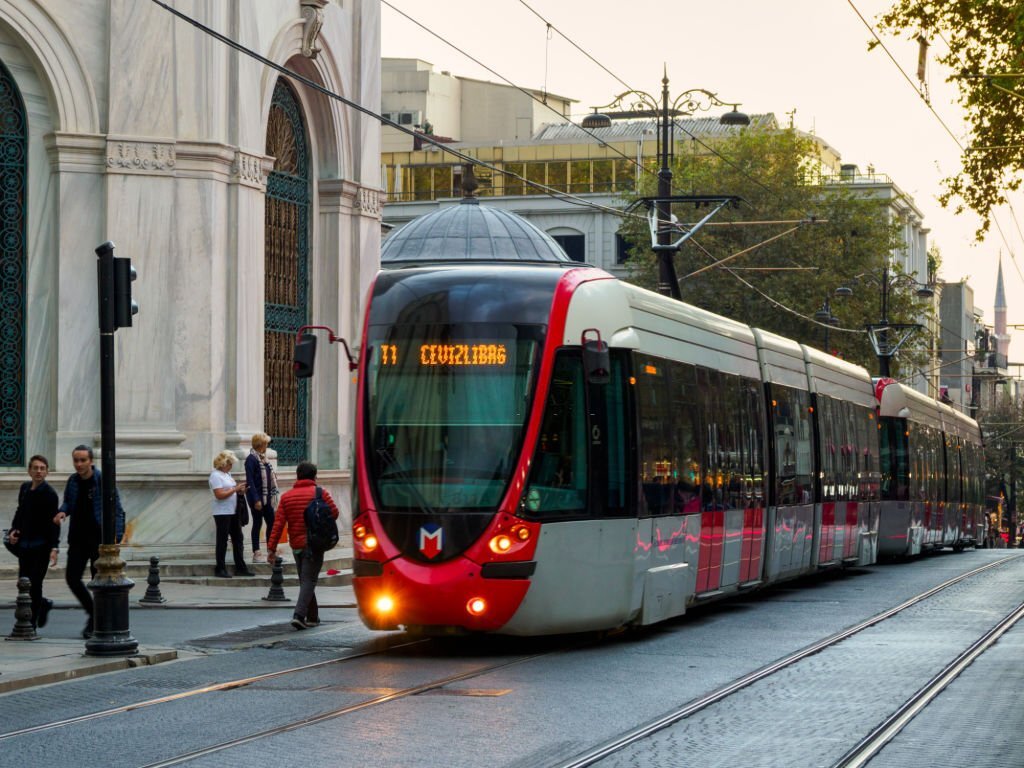
Northward to Sirkeci Station, Eminönü, and Across the Galata Bridge
Leaving Sultanahmet, the old part of Istanbul behind, the T1 tram heads north, passing by Sirkeci Station and the bustling Eminönü district with its busy ferry docks. The route then takes passengers across the iconic Galata Bridge, which spans the Golden Horn and connects the city’s historic and modern districts. This scenic crossing offers stunning views of the city’s skyline and waterfront.
Karaköy Square, Tophane, and the Journey to Kabataş
After crossing the Galata Bridge, the tram arrives at Karaköy Square in the vibrant Galata district. From here, passengers can access the Tünel, a historic underground railway that leads to the bustling shopping street of Istiklal Caddesi in Beyoğlu. Continuing along the T1 tram route, you’ll reach Tophane, where the Istanbul Modern Art Museum awaits. Finally, the tram arrives at its last stop, Kabataş. This seaside district is home to the “Sea Bus” catamaran ferry dock and the Füniküler (funicular tram), which transports passengers to Taksim Square, the heart of modern Istanbul.
Exploring Istanbul’s Rich Heritage with Guided Walking Tours
If you are not a fan of public transportation, we recommend taking guided walking tours in Istanbul’s Old City as an enriching alternative to using the Tram T1 line. You’ll gain valuable insights and uncover hidden treasures that make your experience more memorable than simply visiting landmarks by yourself!
Touristic T1 Tram Stations: A Gateway to Istanbul’s Wonders
Istanbul’s T1 tram line is a convenient and efficient way for tourists to explore the city’s most iconic and historically significant sites. This section will focus on the key touristic stations along the T1 tram route, providing a brief overview of each station and the attractions within walking distance.
Zeytinburnu Tram Station: A Convenient Stop for Shopping
Zeytinburnu Tram Station was once the primary transit stop for tourists traveling to and from Ataturk Airport, as it provided a convenient connection to Metro M1 line. However, with the opening of the new Istanbul Airport, Zeytinburnu’s role as a transit hub has diminished.
Despite this change, Zeytinburnu Tram Station remains a popular stop for visitors seeking shopping opportunities in Old Istanbul. The station is the ideal starting point for those wishing to visit the Marmara Forum Shopping Center, which is located nearby. This modern shopping center boasts an extensive selection of shops and activities, offering more variety than the nearby Historia Shopping Mall.
Haseki Tram Station: Access to Historia Shopping Mall
Haseki Tram Station is a convenient stop for visitors looking for shopping options near the Old City’s key accommodation areas, such as Sirkeci, Sultanahmet, Beyazit, and Laleli. The station is within walking distance of Historia Shopping Mall, one of Istanbul’s medium-sized shopping centers.
While Istanbul boasts larger and more popular shopping malls like Istinye Park, Kanyon, Cevahir Mall of Istanbul, Akasya, and Zorlu Center, Historia remains the most accessible option for tourists staying in the hotels of Istanbul’s Old City.
Aksaray Tram Station: Your Gateway to the Asian Side
Aksaray Tram Station is a vital transportation hub in Istanbul, as it connects travelers with the Marmaray and Yenikapı Ferryboat Station. After alighting at Aksaray, you can reach the Marmaray Station within a few minutes on foot, making it easy to explore the Asian Side of Istanbul.
The Marmaray Under-Sea Metro allows you to cross the Bosphorus in record time, outpacing any sea vessel. By taking the Marmaray from Aksaray, you can reach Sirkeci (the heart of the Old City) in just 4 minutes, Uskudar (Asian Side) in 8 minutes, and Ayrilik Cesmesi (Kadikoy district on the Asian Side) in 12 minutes.
Read: How to Get from European Side to Asian in Istanbul: Full Guide with Fares (2024)
Beyazit Tram Station: Gateway to the Grand Bazaar
Beyazit Tram Station is conveniently located right next to the Grand Bazaar, with Gate 7 being the closest entrance to the tram station. This gate, one of the main entrances to the Grand Bazaar, leads you to the central street, “Kalpakcilarbasi Caddesi.”
Upon entering through Gate 7, you can exit through Gate 1 by walking along the main street and easily reach Sultanahmet via Nuruosmaniye Street. Nuruosmaniye Street, located outside the Grand Bazaar, is a beautiful walking path lined with luxury shops.
While navigating between the main gates, Gate 7 and Gate 1, may seem straightforward, it’s quite easy to get lost in the Grand Bazaar, with its 67 streets and 3,000 shops.
Sultanahmet Tram Station: The Heart of Old Istanbul
Sultanahmet Tram Station is the most crucial stop on Tram T1 line, as it provides easy access to iconic structures of Istanbul such as the Blue Mosque, Hagia Sophia, Basilica Cistern, and Topkapi Palace. As shown on the map above, most of the historical monuments in Old Istanbul are located around Beyazit, Sultanahmet, and Gulhane Tram Stations.
Exploring these historical buildings and museums in Sultanahmet will take an entire day. Afterward, you can take the tram to Taksim to discover Istanbul’s vibrant nightlife.
Gulhane Tram Station: Access to Istanbul Archaeological Museum and Gulhane Park
Gulhane Tram Station allows you to reach Istanbul Archaeological Museum and Gulhane Park on foot. Although these two significant tourist attractions are located within the walls of Topkapi Palace, they can be easily accessed from Gulhane Tram Stop.
To reach these sites, you need to pass through the “Gulhane Gate,” the secondary gate of Topkapi Palace. Upon entering through this gate, you will be greeted by the magnificent Gulhane Park. Following the path in front of you to the right and up a slight slope, the Istanbul Archaeology Museum will be on your left.
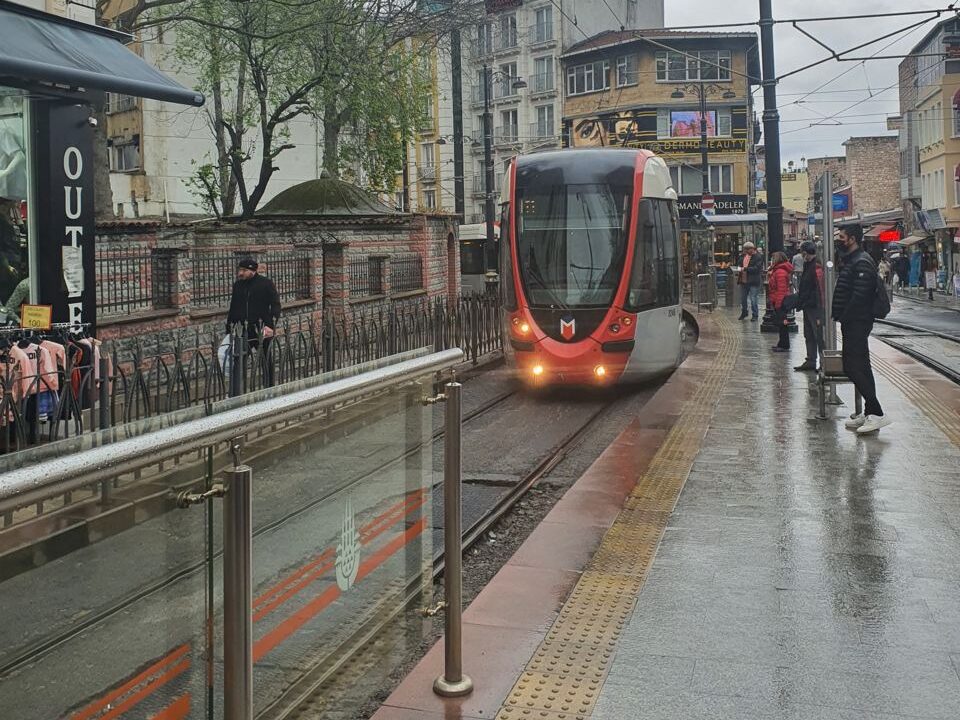
Sirkeci Tram Station: Historical Charm and Culinary Delights
Sirkeci Tram Station is situated in the heart of Istanbul’s Old City, a bustling neighborhood that has been one of the city’s most significant trading and eating spots since the Ottoman period. The station is located in the middle of a historical square, with Sirkeci Railway Station, the former last stop of the Orient Express train, in one corner.
Sirkeci is renowned for its fantastic street food, offering some of the best Turkish dessert shops and local restaurants. The famous Hocapasha Street houses some of these excellent eateries, including Kasap Osman, one of the best doner places in Istanbul. The Hodjapasha Cultural Center on Hocapasha Street is also home to Istanbul’s best whirling dervish show.
Eminonu Tram Station: Spice Bazaar and Street Food Tours
Eminonu Tram Station is adjacent to the famous Spice Bazaar, where you can purchase Turkish delight, tea leaves, saffron, local nuts, and various spices. The 300-year-old bazaar has a cozy atmosphere compared to the Grand Bazaar. Hamdi, one of the best kebab restaurants in Istanbul, is located nearby, as is the Rustem Pasha Mosque, which showcases beautiful Iznik Tiles.
Many popular street food tours in Istanbul start from the Spice Bazaar, given the delicious local delicacies found in the area, such as doner, kokorec, and fish sandwiches.
Explore Street Food of Istanbul with Guided Tours
Karakoy Tram Station: Cosmopolitan Legacy and European Architecture
Karakoy Tram Station is situated in the center of a historical square in the Karakoy district, which served as the city’s port during the Byzantine and Ottoman periods. As such, Karakoy retains its cosmopolitan legacy. With its 19th-century baroque and neo-classical architecture, Karakoy features a European aesthetic, representing the Westernization of the late Ottoman Empire.
In the side streets of Karakoy, you’ll find delightful sweet shops and local restaurants. You can also walk to the Galata Tower and Istiklal Street from Karakoy, which is home to Galataport, the Istanbul Cruise Port.
Tophane Tram Station: Cultural Attractions and Trendy Neighborhoods
Tophane Tram Station is adjacent to the 16th-century Kilic Ali Pasha Mosque. From Tophane, you can easily walk to Istanbul Cruise Port and Istanbul Modern Art Museum. Tophane is one of the most central areas of Beyoglu, and you can walk to Cihangir, one of Istanbul’s coolest neighborhoods. Cihangir is famous for its antique shops, and the Nobel Prize-winning author Orhan Pamuk’s Museum of Innocence is also located there.
Naif, one of the best breakfast places in Istanbul, is just a 5-minute walk from Tophane Tram Station. Additionally, the Kilic Ali Pasha Hamami, one of the best Turkish baths in Istanbul, is right next to the stop.
Findikli Tram Station: Fine Arts and Ottoman Architecture
Findikli Tram Station is close to Istanbul Cruise Port and Istanbul Modern Art Museum. The Nusretiye Mosque, an Ottoman structure with baroque architecture, is also nearby. Mimar Sinan University, one of Istanbul’s fine arts faculties, is located right next to the Findikli Tram Station. The university is dedicated to Mimar Sinan, the most prolific architect in Ottoman history.
Kabatas Tram Station: Luxurious Hotels and Bosphorus Shores
Kabatas Tram Station provides convenient access to Dolmabahce Palace, one of Istanbul’s most important historical monuments. From Kabatas, you can take a ferry to the Asian Side, join Bosphorus cruise tours, or head to the Prince Islands.
The tram station is located at the intersection of Beyoglu and Besiktas districts, making it close to some of the city’s most luxurious hotels. The Ritz Carlton Istanbul, Swissotel the Bosphorus, and Hilton Istanbul Bosphorus are all within walking distance. Additionally, Vodafone Park stadium, home to Besiktas, one of the city’s most popular football clubs, is easily accessible from the tram station.
From Kabatas Tram Station, you can also take a bus to Besiktas and enjoy a stroll along the Bosphorus shores, taking in the stunning views and vibrant atmosphere of the area.
These 12 touristic tram stations on Istanbul’s T1 line offer visitors a convenient way to explore the city’s rich history, breathtaking architecture, diverse shopping options, and mouthwatering culinary delights. With easy access to the Old City, the Golden Horn, and the Beyoglu district, the T1 tram line is an essential tool for travelers looking to make the most of their time in Istanbul.
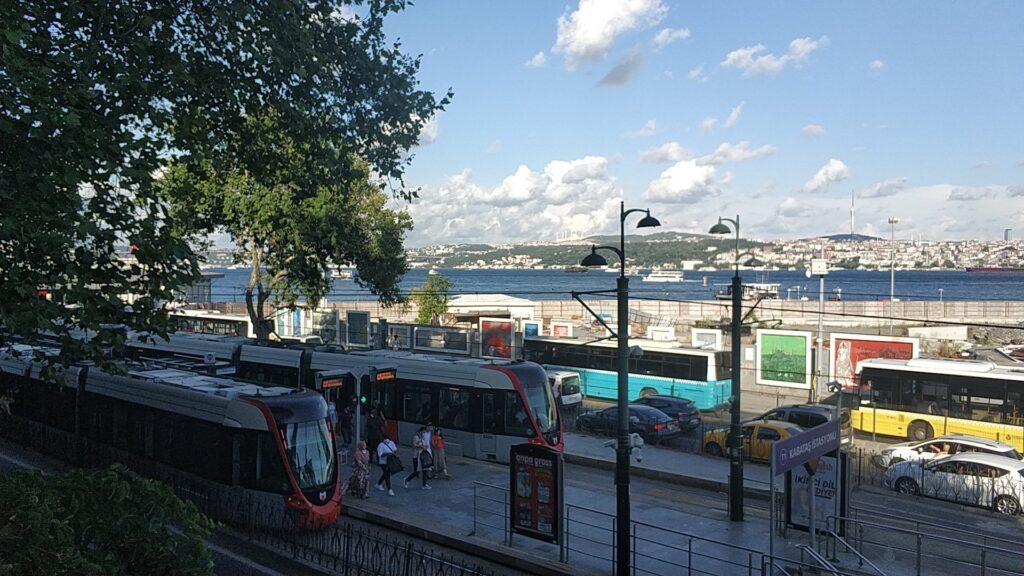
T1 Kabataş-Bağcılar Tram Line Integration: Connecting the City
The T1 tram line is a vital transportation link in Istanbul, providing high capacity and a strategic route that connects various parts of the city. This tram line enables passengers to transfer to numerous other public transportation options at several points along its route, making it an essential tool for navigating Istanbul’s complex transit network.
Here are the key transfer points on the T1 tram line:
- Bağcılar Station: Transfer to the M1B Yenikapı-Kirazlı metro line.
- Zeytinburnu Station: Transfer to the M1A Yenikapı-Atatürk Airport metro line and the Metrobus line.
- CevizliBağ-Atatürk Student Dormitory Station: Transfer to the Metrobus line.
- Topkapı Station: Transfer to the T4 Topkapı Mescid-i Selam tram line.
- Yusufpaşa Station: Transfer to the M1A Yenikapı-Atatürk Airport and M1B Yenikapı-Kirazlı metro lines.
- Aksaray Station: Transfer to the M2 Yenikapı-Hacıosman metro line and the Marmaray operation.
- Laleli-Istanbul University Station: Transfer to the M2 Yenikapı-Hacıosman metro line.
- Sirkeci Station: Transfer to the Marmaray operation.
- Eminönü Station: Transfer to sea enterprises.
- Karaköy Station: Transfer to the F2 Karaköy-Beyoğlu historical tunnel line and sea-runways.
- Kabataş Station: Transfer to the F1 Taksim-Kabataş funicular line, City Lines, IDO, and marine engines.
Understanding the T1 Tram Line Signboard: Navigating Istanbul’s Tram System
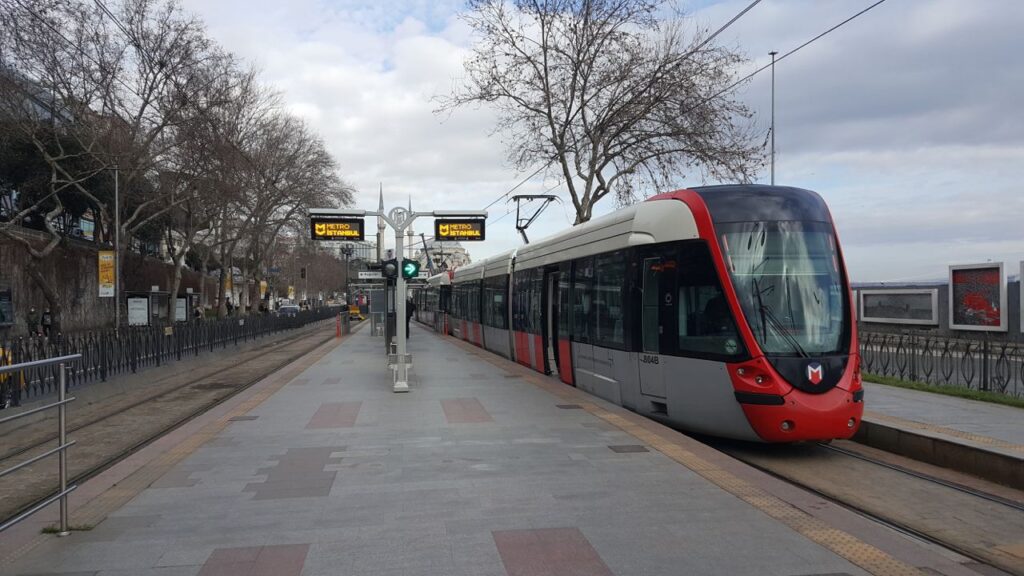
The signboard on the front of the T1 tram is a helpful tool for passengers to understand the tram’s direction and final destination. Here’s a breakdown of what the signboard messages mean:
- Bağcılar: This indicates a westbound/outbound tram heading to the end of the line. It stops at Zeytinburnu, where passengers can transfer to the Metro to reach Atatürk Airport or the Otogar (bus terminal).
- CBG.A.Ö.Y: This signifies a westbound/outbound tram that only travels as far as the Cevizlibağ-Atatürk Ögrenci Yurdu station (just outside the city walls) and not all the way to Bağcılar. Passengers can use this tram for any destination within the city walls. However, if heading to Atatürk Airport, they must disembark at Cevizlibağ (the last stop) and wait for a Bağcılar tram to take them four more stops to Zeytinburnu.
- Eminönü: This refers to an eastbound/inbound tram going towards the city center (Laleli-Üniversite, Beyazıt-Kapalı Çarşı, Sultanahmet, Sirkeci) but only as far as the Eminönü ferry docks. It does not cross the Galata Bridge to Karaköy.
- Kabataş: This indicates an eastbound/inbound tram traveling to the end of the line at Kabataş. It passes all stops, going beyond Eminönü and across the Galata Bridge to Karaköy (where passengers can change for Tünel), Tophane, and Kabataş.
Conclusion
Istanbul’s T1 tram line is an efficient and convenient way to explore the city and connect to various modes of public transportation. By understanding the signboard messages on the tram, passengers can easily navigate the system and reach their destinations without hassle. Familiarizing oneself with the tram stations and their nearby attractions also helps travelers get the most out of their Istanbul experience.
FAQ
Q: What is the T1 tram line in Istanbul?
A: The T1 tram line is a major public transportation route in Istanbul that connects Kabataş on the European side to Bağcılar. It passes through various tourist attractions and important transportation hubs.
Q: How do I understand the signboard messages on the T1 tram?
A: The signboard messages indicate the tram’s direction and final destination. Key messages include “Bağcılar” for a westbound tram going to the end of the line, “CBG.A.Ö.Y” for a westbound tram going only as far as Cevizlibağ-Atatürk Ögrenci Yurdu, “Eminönü” for an eastbound tram going only as far as the Eminönü ferry docks, and “Kabataş” for an eastbound tram going to the end of the line at Kabataş.
Q: How do I transfer from the T1 tram line to other public transportation options?
A: The T1 tram line connects with various public transportation options at multiple points along its route. Some notable connections include Metro lines M1A, M1B, and M2, the Marmaray, Metrobus, and ferry services.
Don’t Miss The Best Tours and Cruises in Istanbul